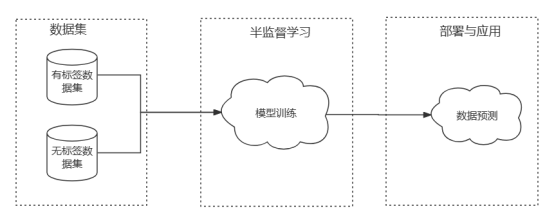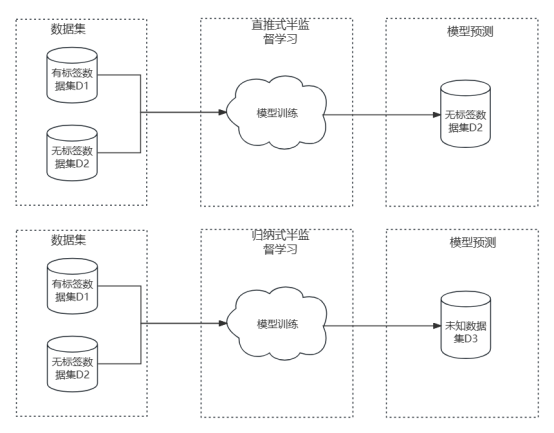 Technology peripherals
Technology peripherals
 AI
AI
 Rewritten title: Exploring the application areas of semi-supervised learning and its related scenarios
Rewritten title: Exploring the application areas of semi-supervised learning and its related scenarios
Rewritten title: Exploring the application areas of semi-supervised learning and its related scenarios

Labs Introduction
With the development of the Internet, enterprises can obtain more and more data. This data helps companies better understand users, known as customer profiles, and can improve user experience. However, there may be a large amount of unlabeled data in these data. If all data is manually labeled, there will be two problems. First, manual labeling is time-consuming and inefficient. As the amount of data increases, more people will need to be hired and it will take longer, and the cost will be higher. Secondly, as the size of users increases, it is difficult to keep up with the growth of data through manual labeling
Part 01, What is semi-supervised learning
Semi-supervised learning refers to training a model using both labeled and unlabeled data. Semi-supervised learning usually constructs an attribute space based on labeled data, and then extracts effective information from unlabeled data to fill (or reconstruct) the attribute space. Therefore, the initial training set of semi-supervised learning is usually divided into labeled data set D1 and unlabeled data set D2, and then the semi-supervised learning model is trained through basic steps such as preprocessing and feature extraction, and then the trained model is used for Production environment to provide services to users.

Part 02. Assumptions of semi-supervised learning
In order to achieve effective label data supplementation with labeled data "useful" information in the data, making some assumptions about data segmentation and other aspects. The basic assumption of semi-supervised learning is that p(x) contains the information of p(y|x), that is, the unlabeled data should contain information that is useful for label prediction and is different from the labeled data or is difficult to obtain from the labeled data. information extracted from the data. In addition, there are some assumptions that serve the algorithm. For example, the similarity hypothesis (smoothness hypothesis) means that in the attribute space constructed by data samples, close or similar samples have the same label; the low-density separation hypothesis means that there is a decision boundary that can distinguish different labels where there are few data samples. The data.
The main purpose of the above assumption is to show that labeled data and unlabeled data come from the same data distribution.
Part 03, Semi-supervised learning algorithm classification
There are many semi-supervised learning algorithms, which can be roughly divided into Transductive learning and Inductive learning (Inductive model) , the difference between the two lies in the selection of the test data set used for model evaluation. Direct push semi-supervised learning means that the data set that needs to predict the label is the unlabeled data set used for training. The purpose of learning is to further improve the accuracy of the prediction results. Inductive learning predicts labels for completely unknown data sets.

In addition, the steps of common semi-supervised learning algorithms are: the first step is to train the model on labeled data, and then use this model Pseudo-label the unlabeled data, then combine the pseudo-labels and labeled data into a new training set, train a new model on this training set, and finally use this model to label the prediction data set.
Part 04. Summary
The biggest problem with semi-supervised learning is that in many cases, the performance of the model depends on labeled data set, and the quality requirements for labeled data sets are relatively high. Even the prediction accuracy of semi-supervised learning models is not much different from the results of supervised models based on labeled data sets. On the contrary, semi-supervised models are in order to effectively extract the features in unlabeled data. Effective information will consume more resources. Therefore, the development direction of semi-supervised learning is to improve the robustness of the algorithm and the effectiveness of data extraction.
Currently in the field of semi-supervised learning, PU-Learning (positive and negative sample learning) is a popular algorithm. This type of algorithm is mainly applied to data sets with only positive samples and unlabeled data. Its advantage is that in certain scenarios, we can obtain reliable positive sample data sets relatively easily, and the amount of data is relatively large. For example, in spam detection, we can easily obtain a large amount of normal email data
The above is the detailed content of Rewritten title: Exploring the application areas of semi-supervised learning and its related scenarios. For more information, please follow other related articles on the PHP Chinese website!

Hot AI Tools

Undresser.AI Undress
AI-powered app for creating realistic nude photos

AI Clothes Remover
Online AI tool for removing clothes from photos.

Undress AI Tool
Undress images for free

Clothoff.io
AI clothes remover

Video Face Swap
Swap faces in any video effortlessly with our completely free AI face swap tool!

Hot Article

Hot Tools

Notepad++7.3.1
Easy-to-use and free code editor

SublimeText3 Chinese version
Chinese version, very easy to use

Zend Studio 13.0.1
Powerful PHP integrated development environment

Dreamweaver CS6
Visual web development tools

SublimeText3 Mac version
God-level code editing software (SublimeText3)

Hot Topics
 Bytedance Cutting launches SVIP super membership: 499 yuan for continuous annual subscription, providing a variety of AI functions
Jun 28, 2024 am 03:51 AM
Bytedance Cutting launches SVIP super membership: 499 yuan for continuous annual subscription, providing a variety of AI functions
Jun 28, 2024 am 03:51 AM
This site reported on June 27 that Jianying is a video editing software developed by FaceMeng Technology, a subsidiary of ByteDance. It relies on the Douyin platform and basically produces short video content for users of the platform. It is compatible with iOS, Android, and Windows. , MacOS and other operating systems. Jianying officially announced the upgrade of its membership system and launched a new SVIP, which includes a variety of AI black technologies, such as intelligent translation, intelligent highlighting, intelligent packaging, digital human synthesis, etc. In terms of price, the monthly fee for clipping SVIP is 79 yuan, the annual fee is 599 yuan (note on this site: equivalent to 49.9 yuan per month), the continuous monthly subscription is 59 yuan per month, and the continuous annual subscription is 499 yuan per year (equivalent to 41.6 yuan per month) . In addition, the cut official also stated that in order to improve the user experience, those who have subscribed to the original VIP
 Context-augmented AI coding assistant using Rag and Sem-Rag
Jun 10, 2024 am 11:08 AM
Context-augmented AI coding assistant using Rag and Sem-Rag
Jun 10, 2024 am 11:08 AM
Improve developer productivity, efficiency, and accuracy by incorporating retrieval-enhanced generation and semantic memory into AI coding assistants. Translated from EnhancingAICodingAssistantswithContextUsingRAGandSEM-RAG, author JanakiramMSV. While basic AI programming assistants are naturally helpful, they often fail to provide the most relevant and correct code suggestions because they rely on a general understanding of the software language and the most common patterns of writing software. The code generated by these coding assistants is suitable for solving the problems they are responsible for solving, but often does not conform to the coding standards, conventions and styles of the individual teams. This often results in suggestions that need to be modified or refined in order for the code to be accepted into the application
 Seven Cool GenAI & LLM Technical Interview Questions
Jun 07, 2024 am 10:06 AM
Seven Cool GenAI & LLM Technical Interview Questions
Jun 07, 2024 am 10:06 AM
To learn more about AIGC, please visit: 51CTOAI.x Community https://www.51cto.com/aigc/Translator|Jingyan Reviewer|Chonglou is different from the traditional question bank that can be seen everywhere on the Internet. These questions It requires thinking outside the box. Large Language Models (LLMs) are increasingly important in the fields of data science, generative artificial intelligence (GenAI), and artificial intelligence. These complex algorithms enhance human skills and drive efficiency and innovation in many industries, becoming the key for companies to remain competitive. LLM has a wide range of applications. It can be used in fields such as natural language processing, text generation, speech recognition and recommendation systems. By learning from large amounts of data, LLM is able to generate text
 Can fine-tuning really allow LLM to learn new things: introducing new knowledge may make the model produce more hallucinations
Jun 11, 2024 pm 03:57 PM
Can fine-tuning really allow LLM to learn new things: introducing new knowledge may make the model produce more hallucinations
Jun 11, 2024 pm 03:57 PM
Large Language Models (LLMs) are trained on huge text databases, where they acquire large amounts of real-world knowledge. This knowledge is embedded into their parameters and can then be used when needed. The knowledge of these models is "reified" at the end of training. At the end of pre-training, the model actually stops learning. Align or fine-tune the model to learn how to leverage this knowledge and respond more naturally to user questions. But sometimes model knowledge is not enough, and although the model can access external content through RAG, it is considered beneficial to adapt the model to new domains through fine-tuning. This fine-tuning is performed using input from human annotators or other LLM creations, where the model encounters additional real-world knowledge and integrates it
 Five schools of machine learning you don't know about
Jun 05, 2024 pm 08:51 PM
Five schools of machine learning you don't know about
Jun 05, 2024 pm 08:51 PM
Machine learning is an important branch of artificial intelligence that gives computers the ability to learn from data and improve their capabilities without being explicitly programmed. Machine learning has a wide range of applications in various fields, from image recognition and natural language processing to recommendation systems and fraud detection, and it is changing the way we live. There are many different methods and theories in the field of machine learning, among which the five most influential methods are called the "Five Schools of Machine Learning". The five major schools are the symbolic school, the connectionist school, the evolutionary school, the Bayesian school and the analogy school. 1. Symbolism, also known as symbolism, emphasizes the use of symbols for logical reasoning and expression of knowledge. This school of thought believes that learning is a process of reverse deduction, through existing
 To provide a new scientific and complex question answering benchmark and evaluation system for large models, UNSW, Argonne, University of Chicago and other institutions jointly launched the SciQAG framework
Jul 25, 2024 am 06:42 AM
To provide a new scientific and complex question answering benchmark and evaluation system for large models, UNSW, Argonne, University of Chicago and other institutions jointly launched the SciQAG framework
Jul 25, 2024 am 06:42 AM
Editor |ScienceAI Question Answering (QA) data set plays a vital role in promoting natural language processing (NLP) research. High-quality QA data sets can not only be used to fine-tune models, but also effectively evaluate the capabilities of large language models (LLM), especially the ability to understand and reason about scientific knowledge. Although there are currently many scientific QA data sets covering medicine, chemistry, biology and other fields, these data sets still have some shortcomings. First, the data form is relatively simple, most of which are multiple-choice questions. They are easy to evaluate, but limit the model's answer selection range and cannot fully test the model's ability to answer scientific questions. In contrast, open-ended Q&A
 SOTA performance, Xiamen multi-modal protein-ligand affinity prediction AI method, combines molecular surface information for the first time
Jul 17, 2024 pm 06:37 PM
SOTA performance, Xiamen multi-modal protein-ligand affinity prediction AI method, combines molecular surface information for the first time
Jul 17, 2024 pm 06:37 PM
Editor | KX In the field of drug research and development, accurately and effectively predicting the binding affinity of proteins and ligands is crucial for drug screening and optimization. However, current studies do not take into account the important role of molecular surface information in protein-ligand interactions. Based on this, researchers from Xiamen University proposed a novel multi-modal feature extraction (MFE) framework, which for the first time combines information on protein surface, 3D structure and sequence, and uses a cross-attention mechanism to compare different modalities. feature alignment. Experimental results demonstrate that this method achieves state-of-the-art performance in predicting protein-ligand binding affinities. Furthermore, ablation studies demonstrate the effectiveness and necessity of protein surface information and multimodal feature alignment within this framework. Related research begins with "S
 SK Hynix will display new AI-related products on August 6: 12-layer HBM3E, 321-high NAND, etc.
Aug 01, 2024 pm 09:40 PM
SK Hynix will display new AI-related products on August 6: 12-layer HBM3E, 321-high NAND, etc.
Aug 01, 2024 pm 09:40 PM
According to news from this site on August 1, SK Hynix released a blog post today (August 1), announcing that it will attend the Global Semiconductor Memory Summit FMS2024 to be held in Santa Clara, California, USA from August 6 to 8, showcasing many new technologies. generation product. Introduction to the Future Memory and Storage Summit (FutureMemoryandStorage), formerly the Flash Memory Summit (FlashMemorySummit) mainly for NAND suppliers, in the context of increasing attention to artificial intelligence technology, this year was renamed the Future Memory and Storage Summit (FutureMemoryandStorage) to invite DRAM and storage vendors and many more players. New product SK hynix launched last year





